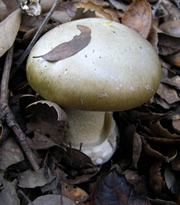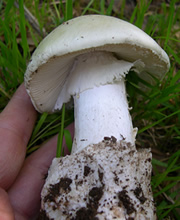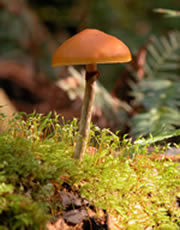mushroom poisonings
Three Deadly Mushrooms
Mushrooms can kill. Eat only what you can identify. These are the three most deadly mushrooms in California:
Amanita phalloides | Amanita ocreata | Galerina marginata (formerly autumnalis)
 © photo by Debbie Viess |
Amanita phalloides, the Death CapAn introduced species, common and spreading, under coast live oak and cultivated cork oak - may be spreading to conifers. Can appear in summer in irrigated areas, fruits into winter. White gills and spores, annulus or skirt present (but can be lost), with a membraneous sac, or volva, at the base of the stem. Cap color variable, from the classic metallic green-yellow, to tan, brown or rarely, white. Most common cause of fatal mushroom poisoning in CA and the US.
|
 © photo by Debbie Viess |
Amanita ocreata, the Destroying AngelUncommon. Our only native deadly amanita. Occurs in mid-winter through spring, under coast live oak. White gills and spores, annulus or skirt present (but can be lost), with a membraneous sac, or volva, at the base of the stem. White cap can show yellow, tan or light brown coloration, especially in the center. Fruit body can be robust, or delicate. Has caused fatalities in CA. |
 © photo by Nathan Wilson |
Galerina marginata, the Deadly Galerina(Formerly called Galerina autumnalis.) Small, delicate, wood-rotting fungus that contains the same deadly toxin as the amanitas above. It has an annulus (which can be lost) and brown spores. Seldom eaten, but has been confused with hallucinogenic mushrooms such as Psilocybes (which have purple-black spores) and may grow in the same habitat. |

 Learn more about Amanita phalloides
Learn more about Amanita phalloides 
 back to top
back to top